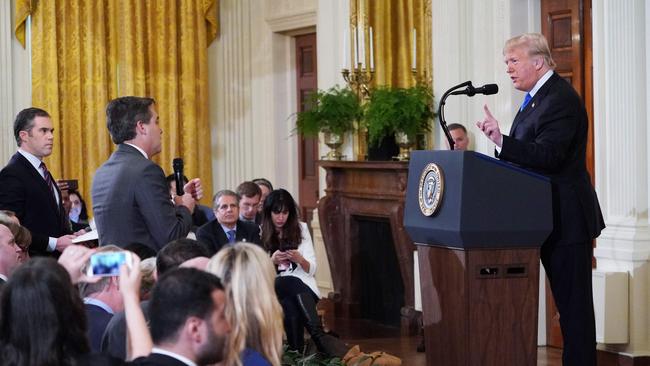Bombshells and bloopers mark media coverage of Trump presidency
US journalists should act as impartial watchdogs rather than anti-Trump campaigners willing to play fast and loose with the truth.

“It was the best of times, it was the worst of times, it was the age of wisdom, it was the age of foolishness.”
The media coverage of Donald Trump is perfectly encapsulated in the famous first sentence from the Charles Dickens novel A Tale of Two Cities. First, let’s talk about the best of times. A plethora of groundbreaking journalism has helped shine a light in dark places and hold the US President to account for his actions.
This has helped breathe life into the financially strapped US media, especially the famous but struggling newspapers The Washington Post and The New York Times, which have seen subscriptions soar on the back of Trump’s roller-coaster presidency.
Pulitzer prizes have been scattered around like confetti for the media’s important work on many aspects of Trump’s presidency, particularly his dealings with Russia and the FBI — the focus of special counsel Robert Mueller’s Russia investigation.
But the media has made a number of monumental blunders in its coverage of Trump. These bloopers tend to be noticed less than the factual scoops — in part because the guilty media outlets bury their mistakes quickly by wiping their websites clean. The pace of the 24-hour news cycle also obscures them soon enough.
What’s more, because most of the media in the US is openly anti-Trump there is less public outrage attached to these mistakes.
The Times and the Post have broken some of the most important, accurate and damaging stories on the Trump presidency. Yet both papers have also lurched further to the left during the Trump presidency, blurring standard news stories with opinion to such a degree that they are no longer papers of record but of opinion.
The 24-hour news networks CNN and MSNBC are even more extreme. They report on Trump only through the filter of their abhorrence for him, while on the other side Fox News views Trump almost exclusively through the lens of adoration.
Journalist Glenn Greenwald, who recently rated the worst US media failures on the Trump-Russia story for The Intercept, noted his list was “difficult to compile in part because news outlets — particularly CNN and MSNBC — often delete from the internet the video segments of their most embarrassing moments”.
He says the anti-Trump bias in the US media is such that “all of the ‘errors’ go in one direction only: namely exaggerating the grave threat posed by Moscow and the Trump circle’s connection to it”.
Mobile users click here to see pdf
But before we take a look at the genuinely “fake news”, let’s remind ourselves of some of the best accurate scoops on the Trump presidency.
One of the rare US scoops with relevance to Australia came only days after Trump was inaugurated when the Post detailed the content of Trump’s explosive phone conversation with then prime minister Malcolm Turnbull.
The paper reported that Trump had fumed to Turnbull that his predecessor Barack Obama’s agreement to accept refugees from Nauru was “the worst deal ever” and that Australia was seeking to export the “next Boston bombers” to America.
Trump abruptly ended the call saying it was “the worst one by far” of all his calls with world leaders.
Trump derided the Post’s front-page report as fake news but six months later the transcript of the call was leaked, proving the paper’s scoop to be accurate.
The New York Times led the way in breaking the explosive story that former FBI chief James Comey had written notes about his meetings with Trump. The paper revealed these notes contained Comey’s claims that Trump tried to persuade him to drop the FBI investigation into the president’s former national security adviser Michael Flynn.
The report said Trump demanded Comey’s “loyalty”, among other things. These notes have since become pivotal to the Mueller inquiry examining whether Trump is guilty of seeking to obstruct justice.
Another major Times scoop revealed that the President’s son Donald Trump Jr, son-in-law Jared Kushner and campaign chairman Paul Manafort had held a meeting two weeks after Trump’s nomination with a Russian lawyer connected to the Kremlin who claimed to have dirt on Democrat nominee Hillary Clinton.
And then there was The Wall Street Journal’s scoop on Trump’s payment of hush money through his now disgraced lawyer Michael Cohen to win the silence of two women who claimed to have had affairs with the President.
But now let’s take a look at the howlers, the stories that should never have been printed or broadcast because journalists were too hasty in believing unreliable sources or were simply carried away with the excitement of potentially delivering a damaging exclusive on Trump.
The most memorable recent piece of fake news was the explosive claim by BuzzFeed that “President Trump personally directed his long-time attorney Michael Cohen to lie to Congress about negotiations to build a Trump tower in Moscow in order to obscure his involvement”.
This promised to be BuzzFeed’s Watergate moment. If true, it would have meant Trump had committed a felony, bringing him a step closer to facing impeachment. Media organisations raced to confirm the report attributed to two unnamed federal law enforcement officers who knew about the Mueller probe.
But no other journalist could find any evidence to support such a claim. Although cable news channels reported the BuzzFeed claims repeatedly, none could confirm or advance them.
Then, in an unprecedented move, Mueller’s office issued a simple but devastating denial.
“BuzzFeed’s description of specific statements to the special counsel’s office, and characterisation of documents and testimony obtained by this office, regarding Michael Cohen’s congressional testimony are not accurate,” said Mueller spokesman Peter Carr.
BuzzFeed has stood by the report, but it stands alone.
Another explosive report that would have had grave implications for Trump was The Guardian’s claim in November that Manafort had secretly met WikiLeaks founder Julian Assange three times in his hideout at the Ecuadorean embassy in London.
If true, it would have established the first direct contact between one of the President’s associates and WikiLeaks, which released Russian-hacked emails damaging to Clinton.
Yet the story didn’t pass the smell test from the beginning. The Ecuadorean embassy where Assange is living is one of the most surveilled buildings in the world, yet no footage has emerged of Manafort coming or going.
The story was denied by Ecuadorean embassy officials as well as by WikiLeaks and it went nowhere after US and British media failed to confirm any of The Guardian’s claims.
The Guardian has never admitted the story was wrong, although it has changed its reference to the alleged Manafort meeting from “the meeting” to “the apparent meeting”.
One of the more colourful media bloopers was CNN’s report in June 2017 that the President’s aide Anthony Scaramucci was involved with the Russian Direct Investment Fund, which was under investigation by the US Senate days before Trump’s inauguration.
This would also have provided a direct link between the Trump campaign team and Moscow. CNN relied on a single anonymous source for the story and when Scaramucci strongly denied it and threatened legal action, the network was forced to retract.
Within a week three CNN staffers had resigned over the story, which the network admitted “did not meet CNN’s editorial standards”.
Arguably the most absurd and incompetent story on Trump was CNN’s claim that in September 2016 Trump Jr was offered, via email, advance access to the hacked emails relating to the Democrats and Clinton before WikiLeaks made them public.
If true, it would have directly linked the Republican candidate’s son to the Russian-hacked emails.
Astonishingly, CNN got the date of the alleged email wrong. It reported that Trump Jr received the email with the website address for the hacked WikiLeaks documents on September 4, before they had been made public.
In fact, Trump Jr received the email on September 14 — after they had been publicly released. Rather than fully admit its mistake, the network said in a statement only that “the new information indicates that the communication (to Donald Trump Jr) is less significant than CNN initially reported”.
Melania Trump has also had her share of fake news. Last week The Telegraph of London issued a three-paragraph apology for making false statements about her family and her modelling career.
The paper had claimed she was struggling in her modelling career before she met with Trump, that she dropped out of university because of an exam, and that her father was a “fearsome presence” in her family.
“We accept that Mrs Trump was a successful professional model in her own right before she met her husband and obtained her own modelling work without his assistance,” the paper said.
“We apologise unreservedly to the first lady and her family for any embarrassment caused by our publication of these allegations.”
Another potential bombshell from CNN about Trump and Russia that imploded was the claim last July that Cohen was about to tell Mueller that Trump knew in advance about the Trump Tower meeting with the Kremlin-linked Russia lawyer. This would have implicated Trump directly with the Russians and would have contradicted his claims he did not know about the meeting.
But the CNN story was wrong and it went nowhere.
Curiously, one of the biggest reporting mistakes of the Trump era was committed by the Post in November 2016, shortly after the presidential election, when it claimed that “Russian propaganda outlets” had planted or promoted disinformation on more than 200 websites that had been viewed more than 213 million times.
In the years since, we have learned that Russia did have a prominent spy infiltration of Americans social media sites to spread disinformation to influence the US election. But in this case, the Post made the mistake of relying on statistics by a new anonymous group that had classified as “Russian propaganda outlets” a cluster of anti-Clinton websites such as The Drudge Report.
It is worth recounting some of these mistakes to remind ourselves that fake news is out there, as Trump so often claims. These bungles are damaging at a broader level because they feed into the Trump narrative that all media is dishonest and that journalists are “the enemy of the people”.
But Trump doesn’t discriminate between fake news and accurate reports. He uses the term fake news for all news he dislikes, regardless of whether it is correct.
None of this is healthy for a democracy, but it also underlines the fact that the media needs to bear some responsibility for the debate about fake news.
If US and other media want to retain their credibility during the Trump era, they must take responsibility for their failures as well as their successes.
Acting as old-fashioned journalists rather than cheerleaders for a cause would be a good start.
Americans would be better served if more journalists acted as impartial watchdogs to hold the President accountable rather than as anti-Trump campaigners willing to play fast and loose with the truth to suit their agenda.
Cameron Stewart is also US contributor for Sky News Australia.



